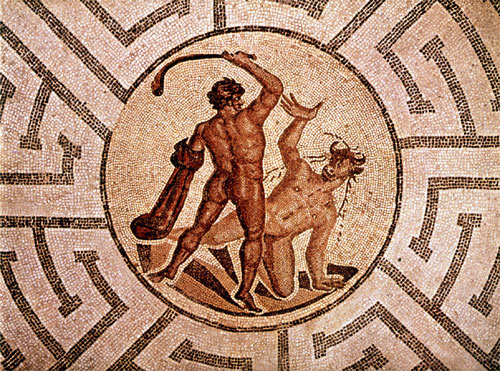
In Greek mythology, the Labyrinth, possibly the building complex at Knossos, was an elaborate structure designed and built by the legendary artificer Daedalus for King Minos of Crete at Knossos.
Its function was to hold the Minotaur, a mythical creature that was half man and half bull and was eventually killed by the Athenian hero Theseus. Daedalus had so cunningly made the Labyrinth that he could barely escape it after he built it. Theseus was aided by Ariadne, who provided him with a skein of thread, literally the “clew”, or “clue”, so he could find his way out again.
In colloquial English, labyrinth is generally synonymous with maze, but many contemporary scholars observe a distinction between the two: maze refers to a complex branching (multicursal) puzzle with choices of path and direction; while a single-path (unicursal) labyrinth has only a single, non-branching path, which leads to the center. A labyrinth in this sense has an unambiguous route to the center and back and is not designed to be difficult to navigate.
Although early Cretan coins occasionally exhibit multicursal patterns, the unicursal seven-course “Classical” design became associated with the Labyrinth on coins as early as 430 BC, and became widely used to represent the Labyrinth – even though both logic and literary descriptions make it clear that the Minotaur was trapped in a complex branching maze.
Even as the designs became more elaborate, visual depictions of the Labyrinth from Roman times until the Renaissance are almost invariably unicursal. Branching mazes were reintroduced only when garden mazes became popular during the Renaissance.
Labyrinths appeared as designs on pottery or basketry, as body art, and in etchings on walls of caves or churches. The Romans created many primarily decorative labyrinth designs on walls and floors in tile or mosaic. Many labyrinths set in floors or on the ground are large enough that the path can be walked. They have been used historically both in group ritual and for private meditation.
Labyrinth is a word of pre-Greek (Minoan) origin, which the Greeks used for the palace of Knossos in Crete, and it is derived from the Lydian word labrys (“double-edged axe”). This was a symbol of royal power, which fits with the theory that the labyrinth was originally the royal Minoan palace in Crete and meant “palace of the double-axe” (the suffix -nth as in Korinth). However the designation “The house of the Double Axe” cannot be limited to the palace of Knossos, because the same symbols were discovered in other palaces of Crete.
Pliny’s Natural History mentions four ancient labyrinths: the Cretan labyrinth, an Egyptian labyrinth, a Lemnian labyrinth, and an Italian labyrinth.
Labrys was a cult-word that was introduced from Anatolia. In Labraunda of Caria the double-axe accompanies the storm-god Zeus Labraundos. It also accompanies the Hurrian god of sky and storm Teshub (his Hittite and Luwian name was Tarhun).
A lot of these symbols were found in the Minoan palaces in Crete, and they usually accompanied goddesses. It seems that the double-axe was the symbol of the beginning (arche) of the creation.
The goddess of the double-axe probably presided over the Minoan palaces, and especially over the palace of Knossos. The Linear B (Mycenaean) inscription on tablet ΚΝ Gg 702, is interpreted as da-pu2-ri-to-jo-po-ti-ni-ja (labyrinthoio potnia, “Mistress of the labyrinth), and she was undoubtedly the goddess of the palace.
The word daburinthos (labyrinthos) may possibly show the same equivocation between initial d- and l- as is found in the variation of the early Hittite royal name Tabarna / Labarna (where written t- may represent phonetic d-).
The complex palace of Knossos in Crete is usually implicated, though the actual dancing ground, depicted in frescoes at Knossos, has not been found. Something was being shown to visitors as a labyrinth at Knossos in the 1st century AD (Philostratos, De vita Apollonii Tyanei iv.34).
The labyrinth is the referent in the familiar Greek patterns of the endlessly running meander, to give the “Greek key” its common modern name. In the 3rd century BC, coins from Knossos were still struck with the labyrinth symbol. The predominant labyrinth form during this period is the simple seven-circuit style known as the classical labyrinth.
The term labyrinth came to be applied to any unicursal maze, whether of a particular circular shape (illustration) or rendered as square. At the center, a decisive turn brought one out again. In Plato’s dialogue Euthydemus, Socrates describes the labyrinthine line of a logical argument:
“Then it seemed like falling into a labyrinth: we thought we were at the finish, but our way bent round and we found ourselves as it were back at the beginning, and just as far from that which we were seeking at first.” … Thus the present-day notion of a labyrinth as a place where one can lose [his] way must be set aside. It is a confusing path, hard to follow without a thread, but, provided [the traverser] is not devoured at the midpoint, it leads surely, despite twists and turns, back to the beginning.
Filed under: Uncategorized
